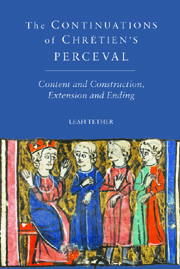Book contents
- Frontmatter
- Contents
- Acknowledgements
- Abbreviations and MS Sigla
- Introduction
- 1 Authorial Changeovers in the Manuscripts
- 2 Distinguishing Continuations, Sequels and Ends
- 3 The First Continuation and Prolongation
- 4 The Second Continuation and the Imitative Mode
- 5 The Gerbert and Manessier Continuations: Interpolation vs. Conclusion
- Conclusion
- Appendices
- Bibliography
- Index
- ARTHURIAN STUDIES
4 - The Second Continuation and the Imitative Mode
Published online by Cambridge University Press: 05 February 2013
- Frontmatter
- Contents
- Acknowledgements
- Abbreviations and MS Sigla
- Introduction
- 1 Authorial Changeovers in the Manuscripts
- 2 Distinguishing Continuations, Sequels and Ends
- 3 The First Continuation and Prolongation
- 4 The Second Continuation and the Imitative Mode
- 5 The Gerbert and Manessier Continuations: Interpolation vs. Conclusion
- Conclusion
- Appendices
- Bibliography
- Index
- ARTHURIAN STUDIES
Summary
The First and Second Continuations, as we saw in the Introduction, are widely divergent in terms of the impressions they give the reader as to their respective narrative strategies, or, as Grigsby puts it, the Second Continuation ‘exhibits a chiastic relationship to its predecessor’. As such the Second Continuation raises a set of questions very different from those raised by the First Continuation, owing to what Bruckner terms the ‘deference shown to Chrétien's romance model’ by the Second Continuator in comparison with the ‘reinvention’ of the First Continuator. This chapter, therefore, aims to approach the Second Continuation by applying a similar method to that used in Chapter 3 for the First Continuation, such that it will be possible for the structures of these two texts to be efficiently compared with each other. To this end, the chapter will begin with a brief survey of redactions, date of composition and authorship which is designed to supplement that provided in the Introduction. I will also consider the evidence as to whether the Second Continuation has an ‘end’ or not, so as to designate it, provisionally, as either a Conclusion or an Extension. I shall then embark on the analysis proper by applying our definition of Continuation to the Second Continuation in order to officially confirm its status as a continuatory text. I shall complete the chapter with an analysis exploring the depictions of the merveilleux and how they may be used as a lens for gleaning a better understanding of the mechanics of Continuation within this particular text and, by extension, how the principles of Continuation may actually contribute to the merveilleux of the text.
- Type
- Chapter
- Information
- The 'Continuations' of Chrétien's 'Perceval'Content and Construction, Extension and Ending, pp. 142 - 164Publisher: Boydell & BrewerPrint publication year: 2012

